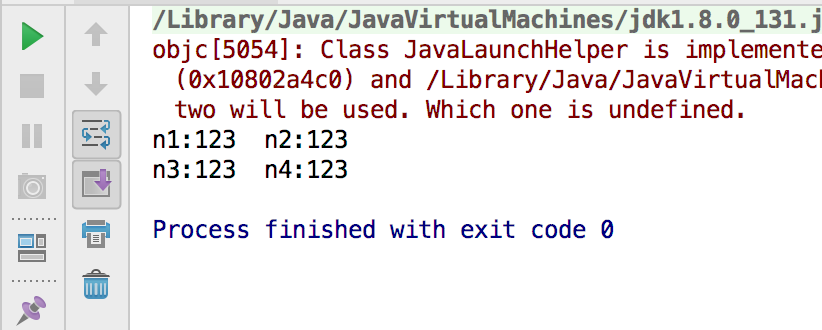廖雪峰Java4反射与泛型-1反射-4调用构造方法
1.Class.newInstance()只能调用public的无参数构造方法
public class Main {
public static void main(String[] args) throws InstantiationException,IllegalAccessException{
String s = (String) String.class.newInstance();
Integer n = (Integer) Integer.class.newInstance();//Interger没有无参数的public构造方法会提示实例化失败
}
}

2.调用带参数的Constructor
Constructor对象包含一个构造方法的所有信息,可以用它来创建一个实例。
如Integer有2个构造方法,1个传入数字,1个传入字符串

Main.java
import java.lang.reflect.Constructor;
import java.lang.reflect.Field;
import java.lang.reflect.InvocationTargetException;
public class Main {
public static void main(String[] args) throws InvocationTargetException,InstantiationException, IllegalAccessException, NoSuchMethodException {
Integer n1 = new Integer(123);
Integer n2 = new Integer("123");
System.out.println("n1:"+n1+"\t"+"n2:"+n2);
Class cls = Integer.class;
Constructor cons1 = cls.getConstructor(int.class);
Integer n3 = (Integer) cons1.newInstance(123);
Constructor cons2 = cls.getConstructor(String.class);
Integer n4 = (Integer) cons2.newInstance("123");
System.out.println("n3:"+n3+"\t"+"n4:"+n4);
}
}

3.通过Class实例获取Constructor信息
- getConstructor(Class...):获取某个public的Constructor
- getDeclaredConstructor(Class...):获取某个Constructor,包括非public的
- getConstuctors():获取所有public的Constructor
- getDeclaredConstructors():获取所有的Constructor,包括非public的。
Constructor总是当前类的构造方法,和继承没有关系,因此也不可能获得父类的Constructor
通过Constructor实例可以创建一个实例对象
- newInstance(Object...parameters)
Hello.java
public interface Hello {
public void hello();
}
Student.java
public class Student implements Hello{
public static int number = 0;
public String name ;
private int age;
public Student(){
this("unNamed");
}
public Student(String name){
this(name,20);
}
private Student(String name,int age){
this.name=name;
this.age = age;
number++;
}
public void hello(){
System.out.println(name+" is Student");
}
}
Main.java
import java.lang.reflect.Array;
import java.lang.reflect.Constructor;
import java.lang.reflect.Field;
import java.lang.reflect.InvocationTargetException;
import java.util.Arrays;
public class Main {
public static void main(String[] args) throws InvocationTargetException,InstantiationException, IllegalAccessException, NoSuchMethodException {
Class cls = Student.class;
Constructor con1 = cls.getDeclaredConstructor(String.class,int.class);//传入参数类型
printConstructor(con1);
con1.setAccessible(true);//允许访问这个构造方法
Student s = (Student) con1.newInstance("小明",12);
s.hello();
}
static void printConstructor(Constructor c){
System.out.println(c);//打印构造方法
System.out.println("parameters: "+Arrays.toString(c.getParameterTypes()));//打印参数类型
System.out.println("modifier:"+c.getModifiers());//打印传入参数个数
}
}

4.SecurityManager
通过设置setAccessible(true)来访问非public构造方法
serAccessible(true)可能会失败:
- 定义了SecurityManager
- SecurityManager的规则阻止对该Constructor设置accessible:例如,规则应用与所有Java和Javax开头的package的类
5.总结
- Constructor对象封装了构造方法的所有信息
- 通过Class实例的方法可以获取Constructor实例:getConstructor()/getDeclaredConstructor()/getConstuctors()/getDeclaredConstructors()
- 通过Constructor实例可以创建一个实例对象:newInstance(Object...parameters)
- 通过设置setAccessible(true)来访问非public构造方法




 浙公网安备 33010602011771号
浙公网安备 33010602011771号